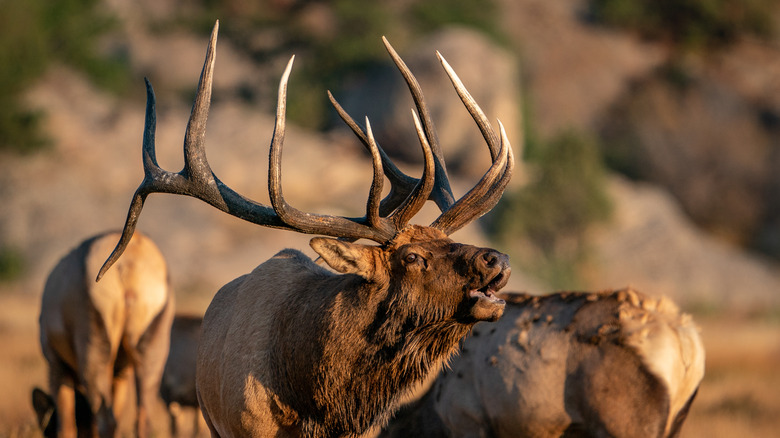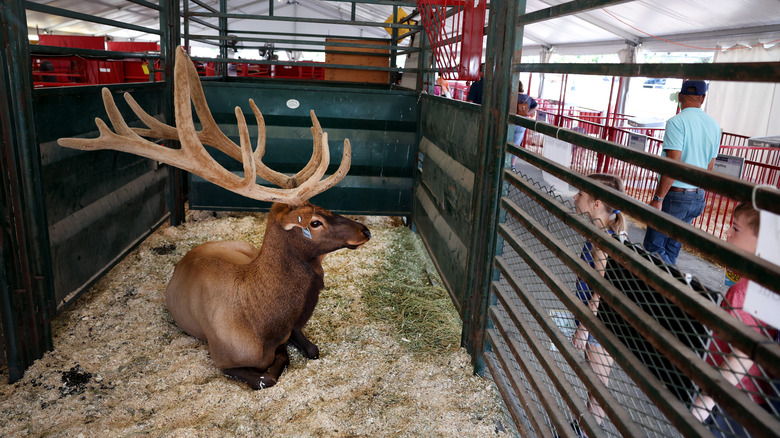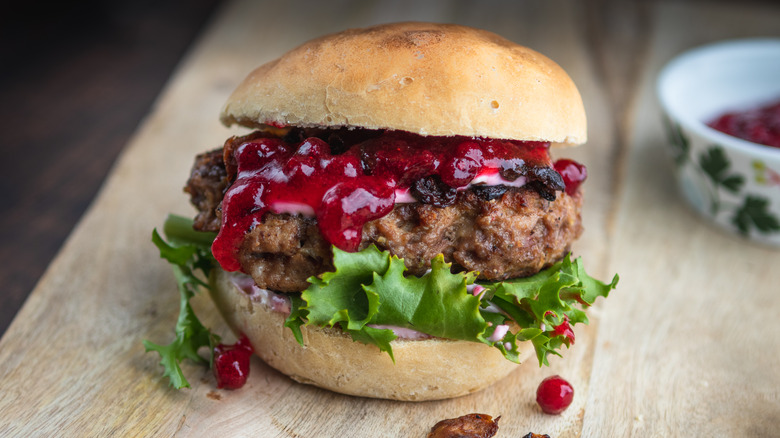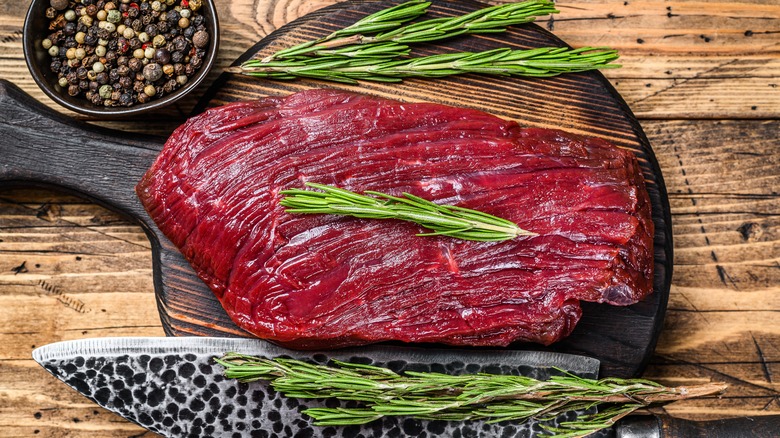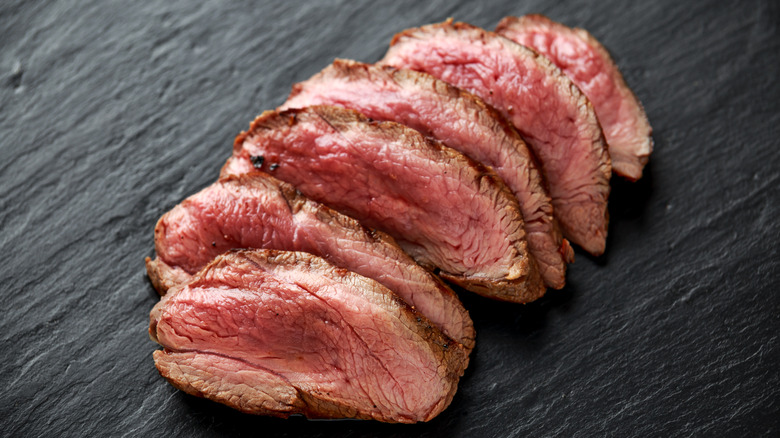Everything You Need To Know About Elk Meat
We may receive a commission on purchases made from links.
If you're a meat eater who lives in America, you likely choose between the familiar standards of beef, pork, and chicken almost every time you eat meat. We're not here to cast aspersions on those animals — all three are obviously delicious and versatile. But don't you ever get bored of eating the same three types of meat for every meal? Not to mention that these animals are often raised using ethically questionable and environmentally ruinous factory farming practices. There are plenty of reasons to seek out alternative sources for your animal protein.
Once you break out of the beef-pork-chicken box, there are so many other exciting and novel meats to explore. In fact, there is a wonderful meat option from an animal that's native to this continent and has formed an integral part of the human diet here for millennia. It provides many of the benefits of beef but with a better nutritional profile, and it's sourced either from hunting wild animals or from small, humane farms. Its name is elk, and it's worth getting to know. If you've never had elk before, we'd wager that after reading this article, you'll be persuaded to give this game meat a try. You might just find it becomes a regular part of your diet.
What are elk?
Before we discuss elk meat, it will be helpful to explain the animal that the meat comes from. Elk are very large members of the deer family. They can weigh up to 1100 pounds and stand up to 5 feet tall at the shoulder. Bull elk grow massive racks of antlers that can add up to 4 feet to the animal's height. Elk are native to North America, and while they used to live across the whole continent, in modern times most elk live in the mountains of the Western U.S. and Canada.
The North American elk may be one of three subspecies of the red deer, an animal that's also found in Asia and Europe. Whether the three types of red deer are actually their own species or just subtypes of the same animal is a matter of debate and ongoing research. The ancestors of modern elk came to North America from Eurasia during the Ice Age. In Europe, the term "elk" is used to describe what people in North America call a moose. North American elk can also be referred to by their Shawnee name, "wapiti." Elk are the second-largest members of the deer family behind moose.
North American elk were an important food source for indigenous people
Elk have historically been hunted by many different indigenous cultures in North America. A variety of tactics were used to catch and lure the animals. Sometimes hunters would use their voices to imitate the calls of elk calves. In other regions, people would use natural materials to make elk whistles. If sounds were not used to entice the animals, hunters could try to sneak up on the elk by disguising their smell or approaching them from downwind. Hunters would take down these giant animals with weapons like arrows, spears, and nets. The hunt could be a group activity as well; in some instances, teams of people and dogs would herd elk into advantageous positions to make it easier to kill them.
Elk weren't just a source of meat; the animals' hides were also quite useful. The leather made from elkskin could be crafted into shoes, clothing, bags, and even body armor (it is quite thick and tough). The bones didn't go to waste, either, as they could be fashioned into sleds and jewelry.
You can still hunt elk today
Hunting is still a fairly common way to procure elk meat in modern times. Of course, with modern guns and other technology, it's a lot easier to bag an elk than it used to be. You can either go on a guided trip (which might be good if you're a novice) or hunt for yourself on public land. Depending on when you're hunting, you have to employ different strategies, as elk behavior and habits change depending on what time of year it is. One popular time to hunt for elk is during mating season (or the rut) when you can use the time-tested trick of blowing on a cow call to imitate the sound of an elk and lure the animals close to you. Once you have an elk in your sights, you have to act quickly and decisively to take it down, as elk can scare easily. They're big and tough, so it might take multiple shots to kill the animal. You want to humanely dispatch the animal and avoid having to chase the wounded elk after hitting it.
Before you set out on an elk hunting adventure, you would do well to look up the rules and regulations surrounding the sport in your area, as they're different from state to state. For example, in order to hunt elk legally in Arizona, you have to sign up for a lottery that awards a limited number of hunting permits.
There are several different types of elk
Although up to this point we've been talking about North American elk as if they were one type of animal, there are actually several subspecies of elk distributed throughout the continent. The most common is the Rocky Mountain elk, or American elk. The largest elk subspecies is the Roosevelt, which lives mostly in the Pacific Northwest. There are also distinct elk varieties native to Central California and parts of Canada.
In addition to the various elk subspecies scattered across North America, there is also a population of elk in New Zealand. The animal is not native to that country — in fact, New Zealand elk are descended from a group of 20 North American elk that were gifted by Theodore Roosevelt. (New Zealand elk tend to be hybrids of North American elk and European red deer.) As in America, elk in New Zealand are popular for sport hunting.
Elk meat is good for you
So now we know what elk are and how you can hunt them, but why would you want to eat elk meat? Apart from its culinary benefits (which we'll get into later), elk meat is also quite healthy and nutritious, according to the United States Department of Agriculture. It's packed with protein, which is vital for the proper functioning of many bodily systems, including your muscles, hormones, tendons, and skin. High-protein foods may also make you feel full for longer and help encourage weight loss. It also contains notable levels of zinc and vitamin B12.
Elk meat is also, in many ways, a nutritionally superior alternative to beef. Its flavor is somewhat similar to grass-fed beef, but it has significantly less fat and fewer calories. Elk is almost as lean as chicken but has a much more robust red meat taste. It might be a good choice if you love beef but are trying to reduce the amount of fat in your diet. Even better, the fats it does contain are healthy ones like Omega-3s and conjugated linoleic acid, per Nation's Restaurant News.
Elk is trending on restaurant menus
Considering all of its health benefits and rich history as a native food source in North America, it's no wonder that elk is becoming more popular on U.S. restaurant menus (via Nation's Restaurant News). According to research from Datassential, it appears on 115% more menus now than it did four years ago and has also increased its name recognition, with two-thirds of Americans reporting that they're familiar with the ingredient.
Although it's more widespread than it used to be, elk is still a niche ingredient in restaurants, with Nation's Restaurant News categorizing it in the Inception stage of the Menu Adoption Cycle (which is the first stage, three steps away from Ubiquity). It's present on less than 1% of the country's menus and despite its high level of name recognition, less than 20% of consumers have actually ever eaten elk. Elk has a long way to go before it approaches the omnipresence of beef or chicken.
The elk served in restaurants is farmed rather than hunted
Elk may be considered to be a game meat, but if you order it at a restaurant, the elk on your plate won't be something that a hunter shot. In most jurisdictions it's against the law to sell wild game in restaurants, so you're probably going to be eating farmed elk.
Elk farming is a fairly recent innovation in America, getting started in the 1970s and becoming more popular in the subsequent decades. Interestingly, this country's elk farming industry was inspired by the success of elk and deer farmers in New Zealand. Despite elk being native to this continent, New Zealand dominated the elk farming industry in the late 20th century, and the country exported large amounts of elk meat to the U.S. However, strong demand and high profitability have spurred the growth of the domestic elk meat industry in more recent years.
Elk has a unique flavor
Elk meat can develop a variety of different flavors depending on the lifestyle of the animal it came from. Farm-raised elk, which tends to eat grain and alfalfa like domestic cattle, is usually milder in flavor and tastes a lot like grass-fed beef with a slightly woodsy edge. Wild elk will likely have a stronger, gamier flavor, and it will taste different depending on what region it lived in and the local plants in the animal's diet. Although elk meat is, on the whole, quite lean, some cuts will still have a decent amount of fat in them.
Much like beef, elk meat's texture varies depending on where in the animal it comes from. Certain cuts are perfect for tender, quick-cooking steaks, while others are tougher and require long cooking to soften them up. Elk can also be used for ground meat that tastes more or less like its beef equivalent, albeit with a touch of the minerality and earthiness that's typical of the animal.
Elk vs. venison
As we've mentioned, the scientific distinction between elk and deer is something of an open question. As such, it's not surprising that there is a fierce debate over whether elk meat and venison (or deer meat) are the same thing.
Supporters of the argument that elk is venison could point to the etymology of the word, which is derived from the Latin term for hunting (venari). Historically, venison could refer to any type of game meat but has more recently come to mean any meat from deer-type animals. This, of course, would include elk.
You may find that argument persuasive, but the fact remains that elk tastes different from the meat of other deer species. The two main differences are that elk meat has less fat than standard venison and it tastes less gamy. Of course, these are only general rules; especially if you're eating wild game, the differences in flavor between individual animals of the same species could be quite dramatic. The sex, age, and even the time of year the animal was hunted can drastically affect the taste of the meat.
How to cook elk
Cooking game meats at home can be intimidating, but it's perfectly doable as long as you remember some simple rules. For elk steaks, you want to cook them as little as possible. The lack of fat in elk can make it a little bit tricky to cook without drying out, but a hard sear on the outside with a bloody rare interior will give you the most tender results. (You should aim for an internal temperature of 120 to 125 degrees Fahrenheit.) You can marinade your elk steaks if you want, but elk is a special, unique product, so you might want to try it simply seasoned with salt so you can appreciate its distinctive character.
For cuts that require longer cooking times, low and slow is the key to achieving tender, juicy results. Braising elk in some kind of flavorful liquid will help prevent it from drying out during cooking. In general, you can cook elk any way you would cook other types of red meat, just making sure to take extra-special care to retain as much moisture in the cooking process as possible.
The different cuts of elk
If you're shopping for elk meat, you'll have a lot of the same choices of cuts as you would for beef or venison. Make sure you buy a cut that will work well for your intended recipe and cooking method. If you're looking for a super-tender steak with a mild flavor, go for tenderloin. Flank is a good choice if you want a quick-cooking steak that can stand up to more robust seasonings.
There are also many great choices for braising and other types of slow cooking. Chops are a beautiful braising cut. Elk ribs are quite similar to beef ribs, though they're a bit earthier in flavor. That slight gaminess would stand up well to smoking, so they would be perfect candidates for turning into barbecue. If you'd like to try your hand at making your own meat snacks, the saddle includes great cuts of meat for homemade jerky.
Where you can buy elk meat
If the idea of donning camo, busting out a gun or bow-and-arrow, and killing your own elk doesn't sound fun to you, don't worry: You can simply buy elk meat. However, you're unlikely to find it at your grocery store or most butcher shops. Thankfully, we live in the age of the internet, so elk meat is just a few clicks away.
There are several online retailers that will deliver fresh elk meat to your door. Some of the purveyors sell New Zealand elk, while others are farms based in the U.S. and Canada. For the most part, no matter where you get your elk meat from, it will be hormone-free, antibiotic-free, free-range, and all-natural.
While mail-order elk certainly isn't the cheapest meat you can buy, given how expensive beef is these days, the prices aren't outrageous. For example, The elk selection from Blackwing Meats ranges in price from around $10 to $30 per pound depending on what cut you select.
You can also buy processed elk products
If you'd like to try elk but don't want to have to figure out how to cook it, you can always pick up some shelf-stable elk snacks. A three-pack of hormone-free, antibiotic-free elk jerky will set you back around $28 on Amazon at the time of writing. That's a little spendy, but jerky is always pricey since so much of the meat's weight is lost during the manufacturing process. Elk jerky would make the perfect road trip companion to chew on as you cruise down the highway.
Many of the specialty mail-order meat companies will also sell you elk snacks directly as well. Northstar Bison makes elk sticks that look like the fanciest Slim Jims you could imagine. The company also makes an elk-based summer sausage. No matter what shape you like your cured meat snacks in, there's a good chance you can find a suitable elk-based alternative for a unique spin on your tried-and-true favorites.


